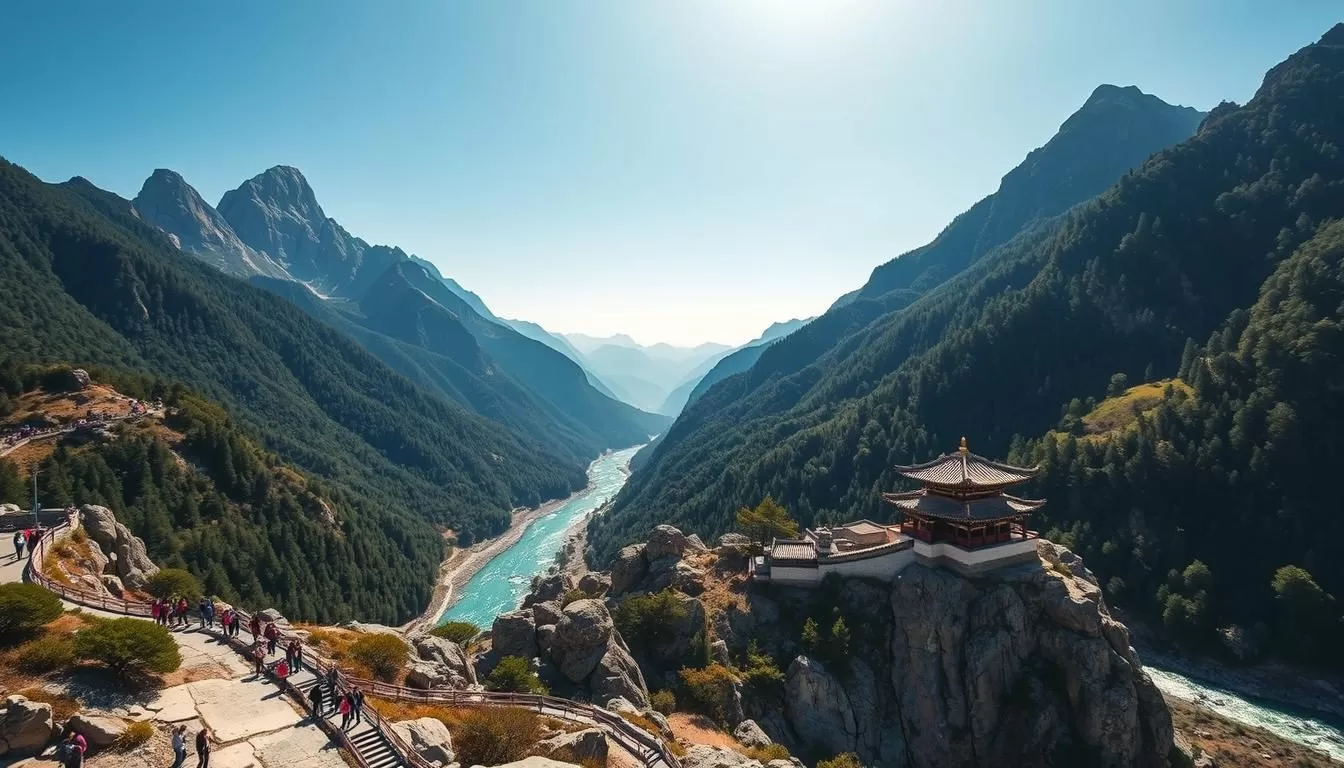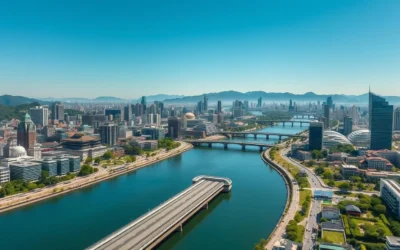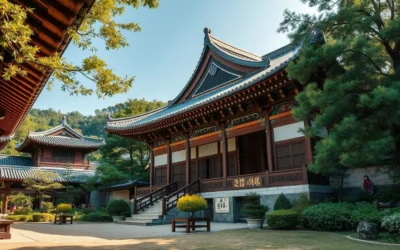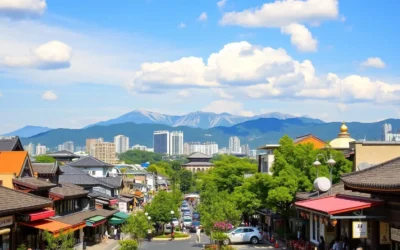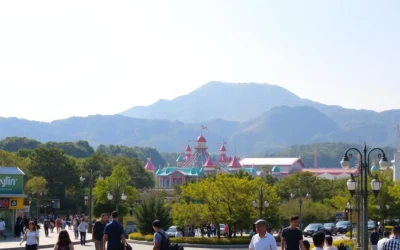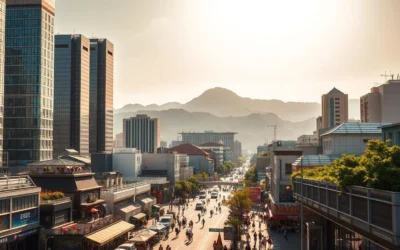✓ Accommodations ✓ Flights ✓ Rental Cars
Nestled in a stunning natural setting, this destination offers a perfect blend of adventure and tranquility. Whether you’re an avid hiker or someone seeking breathtaking views, there’s something here for everyone. The cable car ride is a must-try, offering panoramic sights that will leave you in awe.
With its diverse trails, ranging from easy walks to challenging climbs, this place caters to all skill levels. Autumn is the ideal season to visit, as the landscape transforms into a vibrant canvas of colors. The Ulsanbawi trail, for instance, is a popular choice, taking about 2.5 hours to complete.
Planning your trip is easy, with options like express buses and guided tours available. Whether you’re traveling solo or with family, this destination promises an unforgettable experience. So pack your bags and get ready to explore one of nature’s finest gems!
Overview of Seoraksan National Park
A UNESCO Biosphere Protection site, this location offers unparalleled natural beauty. Nestled in the northeast, it’s a haven for nature lovers and adventure seekers. The rugged peaks and serene valleys create a stunning backdrop for your visit.
Introduction to the Park
This area is known for its diverse trails, ranging from easy walks to challenging climbs. Whether you’re a seasoned hiker or a casual explorer, there’s something for everyone. The scenic streams and waterfalls add to the park’s charm, making it a natural gem.
For those who prefer a relaxed experience, the Biseondae Rock Trail is a great choice. It’s 6 km long and takes about 1.5 to 2 hours to complete. If you’re up for a challenge, the Ulsanbawi Rock Trail offers a rewarding experience with its panoramic views.
What Makes It Unique?
What sets this place apart is its blend of natural and cultural attractions. From the towering Daecheongbong Peak to the historic Sinheungsa Temple, there’s no shortage of wonders to explore. The park’s trails are well-maintained, ensuring a safe and enjoyable experience for all visitors.
Autumn is a particularly magical time to visit, as the landscape transforms into a vibrant canvas of colors. The Cheonbuldong Valley trail, spanning 12 km, is a highlight during this season. Whether you’re here for a day or a weekend, the park promises an unforgettable adventure.
How to Get to Seoraksan National Park
Getting to this stunning destination is easier than you might think, with multiple travel options available. Whether you’re coming from Seoul or nearby cities, there’s a convenient way to reach this natural gem. Planning your trip in advance ensures a smooth and enjoyable experience.
Travel Options from Seoul
If you’re starting your journey in Seoul, buses are the most popular choice. They run every half-hour from the Express Bus Terminal, making it a hassle-free option. The trip takes about 2.5 to 3 hours, depending on traffic, and offers a comfortable ride. Tickets are affordable, with prices ranging from ₩17,200 to ₩28,900, depending on the class.
For those who prefer driving, the journey takes around 2 hours via the highway. Tolls cost approximately ₩11,500 each way, and parking at the park is available for ₩6,000 to ₩10,000. This option gives you the flexibility to explore at your own pace.
Bus, Taxi, and Driving Details
Once you arrive in Sokcho, local buses (Route 7 or 7-1) take you directly to the park entrance. They run every half-hour and the ride lasts about 30 minutes. Taxis are another convenient choice, with fares around ₩23,000.
If you’re short on time, consider booking a guided tour. These often include transportation, making your trip even more seamless. Tours are especially popular during the autumn season, so book early to secure your spot.

No matter which option you choose, planning your logistics carefully will help you make the most of your visit. From buses to taxis, there’s a way to suit every traveler’s needs.
Plan Your Visit: Park Opening Hours & Seasonal Tips
Planning your visit to this breathtaking destination is easier than ever with clear guidelines on opening hours and seasonal highlights. Whether you’re here for a quick day trip or an extended stay, knowing the best times to explore will enhance your experience.
Operating Hours and Cable Car Schedule
The park is open year-round, with operating hours typically from 6:00 AM to 8:00 PM during peak seasons. If you’re planning to take the cable car, it usually runs from 8:30 AM to 5:30 PM, but schedules can vary based on weather and season. Always check the latest updates online to avoid surprises.
Best Seasons for Hiking and Foliage
Spring and autumn are the most popular times to visit, offering ideal conditions for hiking. The trails are vibrant with blooming flowers in spring and stunning foliage in autumn. Winter, while colder, provides a quieter experience with fewer crowds.
Here are some practical tips for your visit:
- Gear up: Wear layers to adapt to changing temperatures, especially during early mornings or late evenings.
- Timing: Arrive early to avoid peak hours and enjoy the trails with fewer people.
- Seasonal shifts: Autumn transforms the landscape into a colorful masterpiece, making it a must-see.
Plan ahead to make the most of your trip. Whether you’re here for the views or the trails, this destination promises an unforgettable adventure.
Exploring the Top Hiking Trails
The rugged beauty of this destination is best explored through its diverse hiking trails, offering something for every adventurer. Whether you’re seeking a challenging climb or a leisurely walk, the trails here cater to all skill levels. Let’s dive into the most iconic routes and what makes them special.
The Challenging Ulsanbawi Rock Trail
The Ulsanbawi Rock Trail is a standout for experienced hikers. This 7.6 km return route takes about 3-4 hours to complete and is known for its steep stone steps and rewarding views. Along the way, you’ll pass scenic spots like Gyejoam Temple and enjoy breathtaking vistas of the surrounding landscape.
This trail is physically demanding, with over 800 steps to conquer. However, the effort is worth it when you reach the top. The panoramic view from the summit is unforgettable, making it a must-do for any hiking enthusiast.
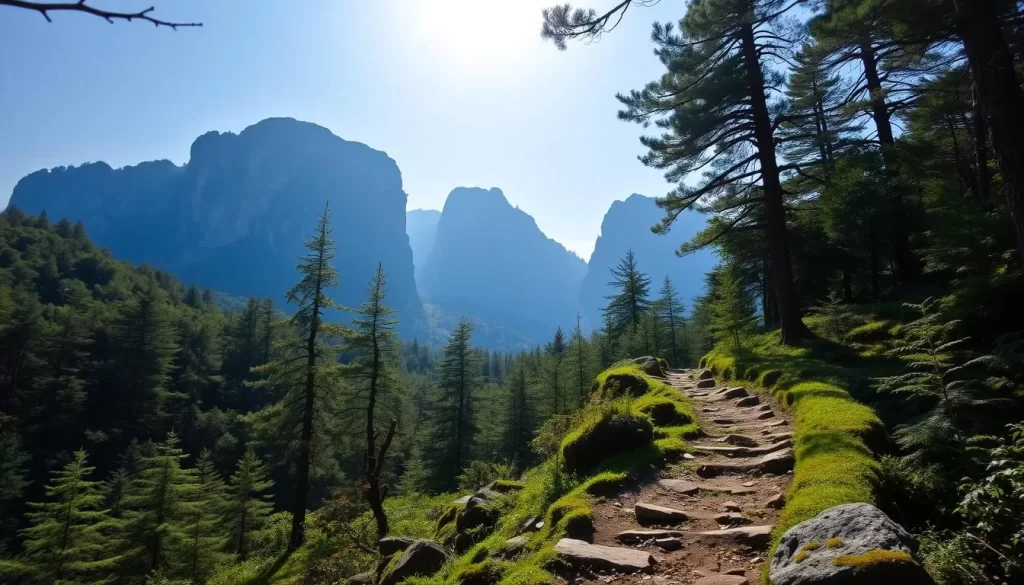
Additional Day Hike Options
If you prefer a less strenuous hike, there are plenty of other options. The Biseondae Rock Trail is a great choice, offering a 6 km route that takes about 1.5 to 2 hours. It’s perfect for families or those looking for a relaxed experience.
For a mix of nature and culture, try the trail to Sinheungsa Temple. This route is shorter but packed with historical and scenic highlights. Whichever trail you choose, proper footwear and pacing are key to enjoying your hike.
Here are some tips to prepare for your adventure:
- Wear sturdy shoes: The terrain can be uneven, so good footwear is essential.
- Bring water and snacks: Stay hydrated and energized throughout your hike.
- Check the weather: Conditions can change quickly, so be prepared for any scenario.
Exploring these trails is a fantastic way to connect with nature and challenge yourself. Whether you’re tackling the Ulsanbawi Rock Trail or opting for a gentler route, you’re in for an unforgettable experience.
Taking the Cable Car for Panoramic Views
For a breathtaking way to experience the landscape, the cable car offers unmatched views of the mountain and valley. This short ride, lasting about five minutes, takes you to a high vantage point where you can soak in the scenery.
How to Purchase Tickets and Timing Guidelines
When you arrive, head to the ticket booth near the main entrance. Tickets are time-specific, so it’s best to buy the nearest available slot. Adult tickets cost ₩15,000, while children pay ₩11,000.
The cable car operates from 9:00 AM to 6:00 PM, but hours can vary based on weather. Weekends are especially busy, so plan to arrive early to secure your spot.
Once on board, enjoy the 360-degree views as you ascend 700 meters in elevation. At the top, take your time exploring the viewing areas and nearby trails. Remember to check for any service suspensions due to maintenance or weather.
Here are some tips to make the most of your ride:
- Arrive early: Beat the crowds and enjoy a more relaxed experience.
- Check the weather: Clear days offer the best visibility for photos.
- Plan your time: Allow extra minutes to explore the upper platform and trails.
Seoraksan National Park, South Korea: Best Things to Do – Top Picks
From scenic hikes to breathtaking cable car rides, this guide covers everything you need for an unforgettable trip. Whether you’re planning a day visit or a longer stay, the variety of activities ensures there’s something for everyone. Let’s recap the highlights to help you make the most of your adventure.
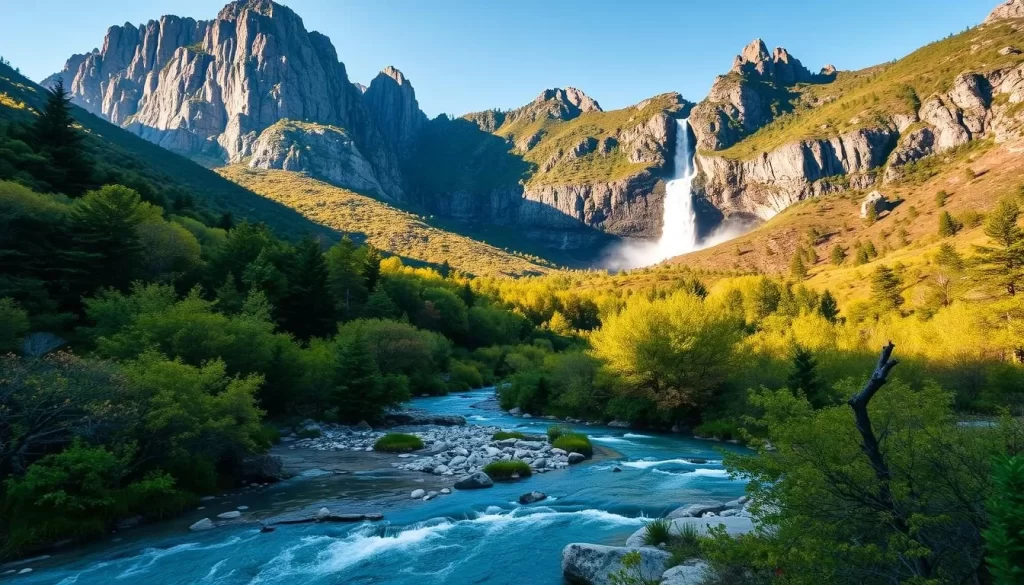
Highlights of the Ultimate Guide
This destination offers a mix of challenging hikes and relaxing experiences. The Ulsanbawi Rock Trail, for instance, is a must for avid hikers, taking about 3-4 hours to complete. If you prefer a gentler pace, the Biseondae Rock Trail is perfect for families and casual explorers.
For panoramic views, the cable car is a top pick. It operates from 8:30 AM to 5:30 PM, weather permitting, and offers stunning vistas of the surrounding landscape. Tickets are affordable, with adult fares at ₩15,000 and child tickets at ₩11,000.
Getting here is easy, with buses running every half-hour from Seoul. Once you arrive, local buses or taxis can take you to the park entrance in about 30 minutes. Planning your trip around the season is key, as autumn transforms the area into a colorful masterpiece.
Here’s a quick summary of what to keep in mind:
- Activities: Choose from hiking trails, cable car rides, and cultural landmarks.
- Transportation: Buses and taxis are convenient options for reaching the park.
- Timing: Autumn is the best season for vibrant foliage and pleasant weather.
This guide reaffirms the park’s status as a must-visit destination. Its natural beauty and unique attractions make it a standout choice for travelers. Continue reading for even more insights and practical tips to enhance your experience.
Discover Scenic Spots and Notable Attractions
Beyond the trails, this destination is home to stunning cultural landmarks and natural wonders that captivate every visitor. From ancient temples to breathtaking waterfalls, there’s so much to explore. These attractions complement the adventurous hikes, offering a well-rounded experience for all.
Ancient Temples and Cultural Landmarks
One of the highlights is the Sinheungsa Temple, a historic site near the cable car station. This temple, with its giant bronze Buddha statue, stands as a symbol of peace and hope. Built in 1997, it’s a must-see for those interested in local history and spirituality.
Another notable landmark is the Seokguram Grotto, a UNESCO World Heritage site. Built during the Silla Dynasty, it’s a masterpiece of Buddhist art and architecture. Its serene atmosphere and intricate carvings make it a cultural treasure.
Waterfalls, Valleys, and Observatories
For nature lovers, the Biryong Falls is a must-visit. This 2.4 km trail leads to a stunning waterfall surrounded by lush greenery. The hike takes about 50 minutes, making it a perfect addition to your day.
The Cheonbuldong Valley is another gem, especially in autumn. The vibrant foliage transforms the area into a colorful paradise. It’s a great spot for photography or simply soaking in the beauty of nature.
For panoramic views, head to the Gwongeumseong Fortress Observatory. Accessible via a short hike or the cable car, it offers breathtaking vistas of the surrounding landscape. It’s an ideal way to end your day with a memorable view.
These attractions provide a perfect balance of adventure and relaxation. Whether you’re exploring ancient temples or marveling at natural wonders, there’s something for everyone to enjoy.
Where to Stay: Accommodation Near the Park
Finding the perfect place to stay near this stunning destination can make your trip even more memorable. Whether you prefer luxury or budget-friendly options, there’s something for everyone. Staying close to the park entrance or in the nearby town of Sokcho offers convenience and comfort.
Convenient Hotels at the Park Entrance
For those who want to be steps away from the trails, the Kensington Hotel is a top choice. Located just a 5-minute walk from the entrance, it’s ideal for early morning hikes. This hotel offers modern amenities, including on-site dining and friendly service, making it a great base for your adventure.
Another excellent option is the Seorak Pine Resort, which features a pool and non-smoking rooms. Its proximity to the cable car station makes it a convenient choice for families and couples alike.
Comfortable Options in Sokcho Town
If you prefer to stay in town, Sokcho offers a variety of accommodations to suit every budget. The Lotte Resort Sokcho is a luxurious option with high ratings and stunning views of the sea. For a more affordable stay, consider the Benikea Hotel Mountain & Ocean, which offers excellent value and comfortable rooms.
Many hotels in Sokcho are close to the bus terminal, making it easy to plan your day trips. For example, the Sea Cruise Hotel is just a short ride away from the park entrance. Booking early, especially during peak seasons, ensures you get the best prices and availability.
For more options, check out hotels near the cable car to find the perfect stay for your needs.
Savor the Local Cuisine and Park Dining Options
After a day of exploring the trails, indulging in the local cuisine is a rewarding way to unwind. The park offers a variety of dining options, from cozy cafes to full-service restaurants, where you can enjoy authentic flavors amidst stunning scenery. Whether you’re craving a hearty meal or a refreshing drink, there’s something to satisfy every palate.
On-Site Restaurants and Cafes
Dahyang Cafe is a popular spot for hikers, known for its signature honey Americano and relaxing ambiance. It’s the perfect place to recharge after a long hike. Another great option is Daraejeong, which serves traditional dishes like seafood haemul pajeon, a savory pancake packed with fresh ingredients.
These on-site eateries not only offer delicious food but also provide a chance to soak in the park’s natural beauty. Prices may be slightly higher than average, but the quality and experience make it worthwhile.
Must-Try Dishes and Special Treats
When visiting, don’t miss out on local specialties like bibimbap, a colorful rice dish mixed with vegetables and meat. For dessert, try patbingsu, a shaved ice treat topped with sweet red beans and fruit. These dishes capture the essence of South Korean cuisine and are perfect for refueling after a day of adventure.
If you’re looking for a quick snack, grab some hotteok, a sweet pancake filled with brown sugar and nuts. It’s a favorite among visitors and locals alike.
For more dining options and culinary experiences, explore Sokcho, a nearby town known for its fresh seafood and vibrant food scene. Whether you’re dining in the park or venturing out, the local flavors are sure to leave a lasting impression.
Travel Tips for a Smooth Experience
Planning your trip to this natural wonder requires some smart strategies to ensure a seamless experience. From handling payments to navigating weather changes, these tips will help you make the most of your visit.
Payment, Ticketing, and Reservation Tips
Using a T-money card is a convenient way to pay for public transport, including buses and subways. It saves time and ensures you’re always ready to go. For tickets to attractions like the cable car, book online in advance to avoid long lines. On-site purchases are possible, but availability can be limited during peak seasons.
If you’re taking the express bus, check the schedule ahead of time. Buses run frequently, but popular routes can fill up quickly. For guided tours, confirm reservations at least a week in advance, especially during autumn when demand is high.
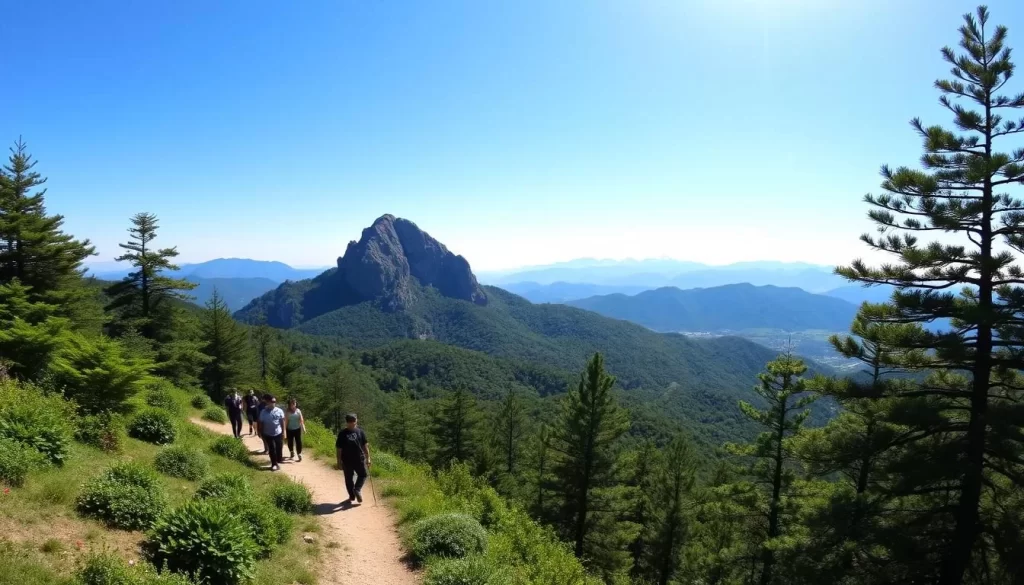
Weather, Safety, and Logistics Advice
Weather in the mountains can change quickly, so pack layers and waterproof gear. Check forecasts daily and be prepared for sudden shifts. Safety is key, especially on challenging trails. Always stay on marked paths and carry a map or GPS device.
For transport, plan your route carefully. Local buses are reliable, but schedules can vary. Taxis are a good backup option if you’re short on time. If you’re driving, note that parking near the park entrance can fill up early in the day.
Here are some additional tips to keep in mind:
- Use local apps: Apps like Naver Maps provide real-time updates on bus schedules and trail conditions.
- Stay hydrated: Carry enough water, especially on longer hikes.
- Respect nature: Follow eco-friendly practices to preserve the beauty of the area.
For more travel inspiration, explore the best places to visit in South. With these tips, your trip will be both enjoyable and hassle-free.
Exploring Nearby Attractions and Day Tours
Your adventure doesn’t end at the trails—nearby attractions and day tours offer even more to explore. From iconic locations like Nami Island to vibrant local markets, there’s something for everyone. These experiences complement your visit, adding depth and variety to your trip.
Nami Island and Other Iconic Locations
Nami Island is a must-visit, known for its picturesque ginkgo tree-lined walkways and seasonal beauty. Located about 108 minutes from Seoul by subway, it’s a perfect day trip destination. The island’s serene atmosphere and scenic views make it a favorite among travelers.
For a mix of nature and culture, consider visiting Suwon Hwaseong Fortress, a UNESCO World Heritage Site. Its 5.74 km-long walls and historic significance offer a glimpse into Korea’s past. These attractions are easily accessible and provide a refreshing break from hiking.
Local Markets and Cultural Experiences
Sokcho’s local markets are a treasure trove of flavors and traditions. The Sokcho Tourist & Fishery Market, established in 1953, features around 450 stores offering fresh seafood and local delicacies. It’s a great place to immerse yourself in the local culture and try authentic dishes.
For a deeper cultural experience, explore Abai Village, known for its traditional boat rides and charming ambiance. A one-way trip costs just 200 won, making it an affordable and memorable activity.
“Exploring nearby attractions is like uncovering hidden gems—each one adds a unique layer to your journey.”
Here’s a quick comparison of popular day tours:
| Tour | Duration | Price |
|---|---|---|
| Mt. Seorak & Naksansa Temple | Full day | ₩75,300 |
| Nami Island & Garden of Morning Calm | Full day | ₩102,500 |
| Alpaca World & Gangchon Rail Bike | Full day | ₩97,400 |
For more day trip ideas, check out this guide to top day trips from Seoul. Whether you’re exploring Nami Island or diving into local markets, these experiences will make your trip unforgettable.
Practical Information and Budget Considerations
Understanding the costs and practical details of your visit ensures a smooth and budget-friendly experience. While the entrance to the park is free, there are still additional expenses to consider, such as the cable car, parking, and meals. Planning ahead helps you avoid surprises and make the most of your trip.
Entrance Fees and Additional Costs
Although the park entrance is free, other services come with a fee. For example, the cable car ride costs ₩15,000 for adults and ₩11,000 for children. Parking fees range from ₩6,000 to ₩10,000, depending on the duration of your stay. These costs are worth it for the convenience and stunning views they offer.
If you’re traveling by bus, the express bus from Seoul costs between ₩17,200 and ₩28,900, depending on the class. Local buses in Sokcho charge around ₩1,200 per ride, making them an affordable option for getting to the park entrance.
Here’s a breakdown of the costs you might encounter during your visit:
| Service | Cost |
|---|---|
| Cable Car (Adult) | ₩15,000 |
| Cable Car (Child) | ₩11,000 |
| Parking (Full Day) | ₩10,000 |
| Express Bus (Seoul to Sokcho) | ₩17,200 – ₩28,900 |
| Local Bus (Sokcho to Park) | ₩1,200 |
To save on expenses, consider packing snacks or meals for your hike. On-site restaurants and cafes are available, but prices can be higher than average.
Here are some tips to help you plan your budget:
- Book in advance: Secure tickets for the cable car and buses early to avoid last-minute price hikes.
- Pack wisely: Bring water, snacks, and sunscreen to save on in-park purchases.
- Use public transport: Local buses are affordable and reliable for getting around.
By keeping these tips in mind, you can enjoy your trip without breaking the bank. Whether you’re hiking the trails or taking the cable car, a little planning goes a long way.
Conclusion
Exploring this stunning destination offers a mix of adventure and relaxation. From scenic hikes to cultural landmarks, there’s something for everyone. The trails cater to all skill levels, whether you’re a seasoned hiker or a casual walker.
Autumn is the ideal time to visit, as the landscape transforms into a vibrant display of colors. The cable car provides breathtaking views, making it a must-try experience. For those arriving by bus, the journey is convenient and affordable.
Plan your trip carefully to make the most of your visit. From knowing the best season to budgeting costs, preparation ensures a smooth adventure. This guide is your go-to resource for creating lasting memories.
Ready to explore? Start planning your trip today and discover the beauty of this incredible destination. For more tips, check out this detailed guide to enhance your experience.
The above is subject to change.
Check back often to TRAVEL.COM for the latest travel tips and deals.
